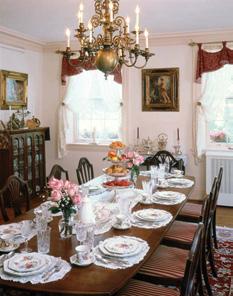
13 minute read
Top 10 Things You Should Know About LEDs
by IdeaSoil


Advertisement
Visit Maxxon at the AIA National Convention Booth # 1253
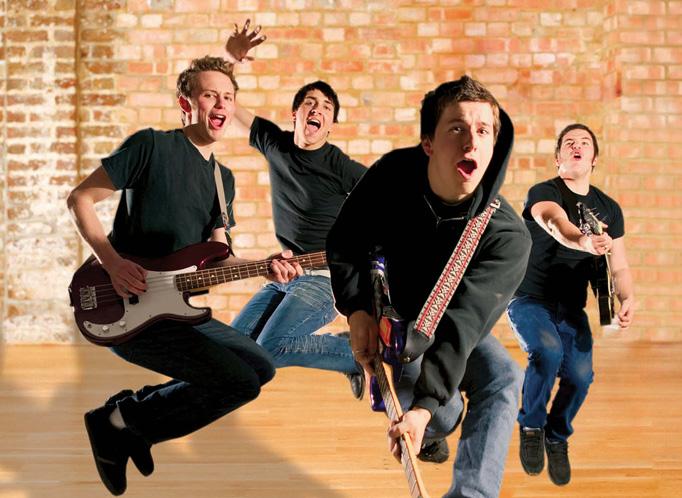


Because one room’s floor is another room’s ceiling
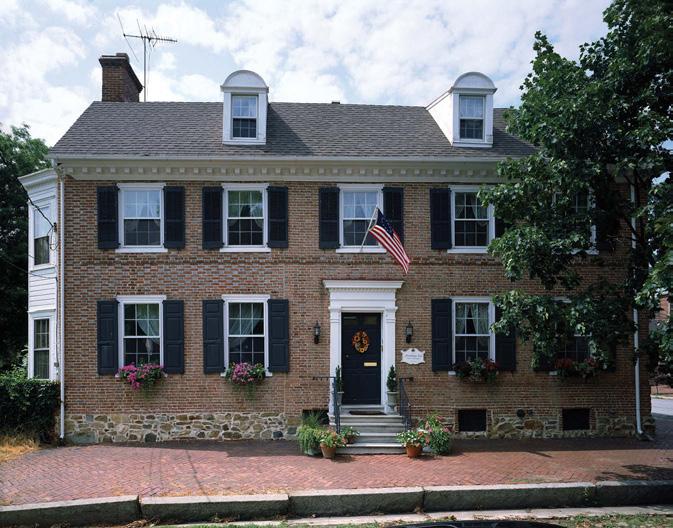
Armitage Inn
A house built in 1730 in New Castle, DE, got a new life when Zinder and his team converted it into a 6,000-sq.-ft. bed and breakfast. JZA+D faced a unique challenge in preserving the historical context while converting the home to a hospitality space. In addition to overhauling the kitchen, replacing the windows, and redesigning the entryway, a key change was the reconfi guration of the three original full bathrooms into six, dedicating one to each guest room. JZA+D selected historically accurate furnishings and even created a new logo for the inn.
A complete line of “green” underlayments and sound control mats:
Raises IIC by up to 17 points in wood frame and 25 points in concrete construction. Documented sound tests over 100 UL Fire Rated Designs Seven levels of sound control Six mats with 40% pre-consumer recycled content
T H E “G R E E N” F L O O R S P E C I A L I S T S
To learn more: 800-356-7887 info@maxxon.com www.Maxxon.com



Palazzo Scrim
Projects under construction are rarely pretty, so when construction of the Palazzo Condo Tower–part of the larger Palazzo Resort Hotel Casino in Las Vegas–was suspended during the recession, its owners enlisted JZA+D to design a solution that would mask the incomplete construction from view for three to six years. The fi rm recommended a scrim that could be suspended six stories above the ground and reach some 90 feet in the air. The scrim features advertisements for entertainment available at the casino’s showrooms.
Do yourbest work.
From concept...
Start with Green Building system design and Taco Hydronic System Solutions® software. You can design a LoadMatch® single pipe system or a LOFlo® radiant cooling/chilled beam system in minutes. It’s that easy!
To comfort...
Every job has its own challenges, so we give you lots of options like our e-smart® sustainable components, our Advantage® Series variable speed drives, and geothermal, solar, and high effi ciency packages to help meet the demands of sustainability and LEED.


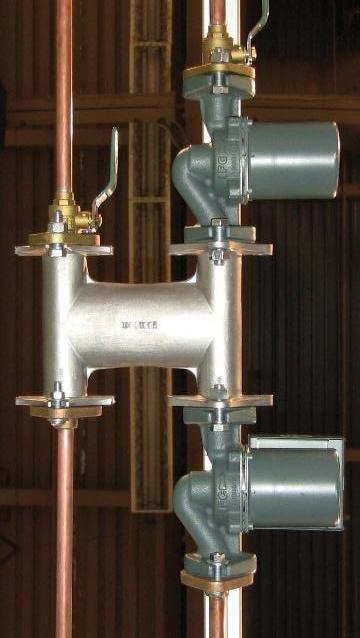
To control.
Once you turn the building over, the facility engineer can monitor, manage, and control both the hydronic and air systems from the comfort of his own PC with iWorx® from Taco Electronic Solutions. iWorx is self-confi guring, expandable, Niagra® compatible, and economical. It requires no proprietary software or knowledge of code.
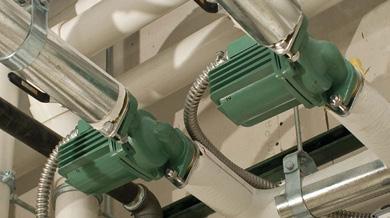
All under one roof
Taco is a family-owned business that understands the value of integrity and customer support. W hen you choose Taco, you’re choosing a whole-business approach to system creation; we’re here from start to fi nish.


ADVANCED HYDRONIC SYSTEMS www.taco-hvac.com
e-smart is our way of helping you identify our most resource-saving products.
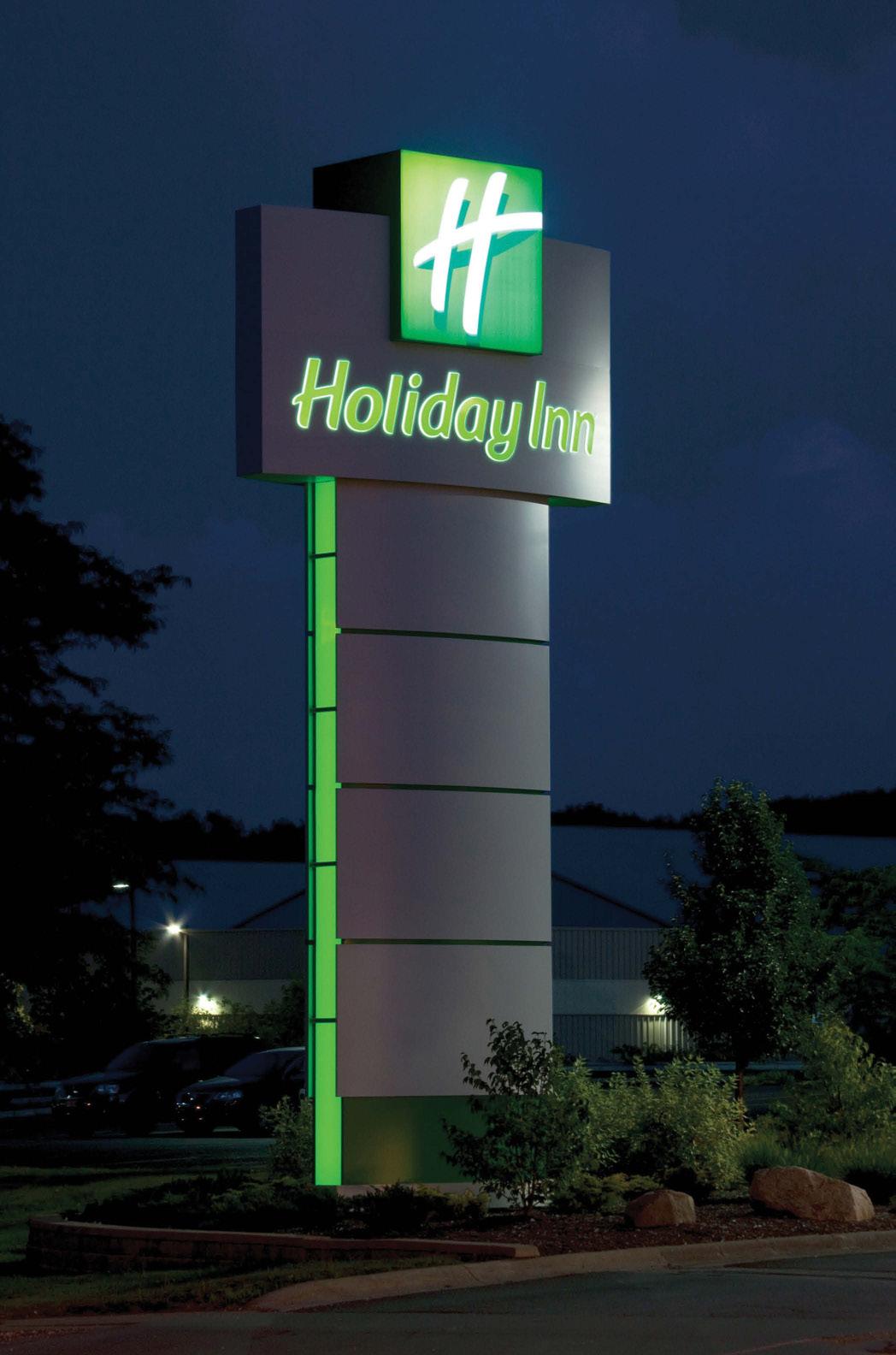




LEDs provide vivid illumination for signs without the “missing” letters or words that happen with conventional light sources.
Top 10 Things You Should Know About LEDs

If you don’t know a Kelvin from a lumen, it’s time to learn about the hottest trend in lighting.
The journey with light-emitting diode (LED) technology dates back to 1962, when GE Lighting, Fairfi eld, CT, scientists invented the fi rst visible LED. Over the past decade, energy-effi cient LED technology has become increasingly common in a variety of applications, such as signage, architectural lighting, display cases, parking-lot lighting, and accent and ambient lighting. As lighting moves into the digital era, energy-conscious architects, facility managers, and building owners are turning to LEDs as their single lighting source. Industry analysts generally forecast that, by 2020, 50% to 80% of all lighting products sold will be LED. If you aren’t on board with LEDs yet, here are the basics about a technology that is here to stay.
1. What is LED technology? When people hear LED, they might fi rst think of televisions. The same technology used in the latest TVs has helped GE Lighting create energysaving lighting solutions for years. This LED technology, also known as solid-state lighting, starts with a tiny chip comprising layers of semiconducting material, where the movement of electrons is converted into light that is emitted from the small light source. In fact, some small chips can emit enough light to illuminate an entire room. Also, LED lamps have heat sinks to release the heat, maintaining optimal LED functionality and keeping the bulb cool to the touch.
2. Is it true that LEDs have a longer life than
traditional incandescent light sources?
Yes, by comparison, LED solutions can enable energy savings as much as 75%, compared with traditional incandescent light sources, while lasting 25 to 50 times longer. The result is drastically reduced energy and maintenance costs.
3. What can we expect with energy effi cien
cy and life-cycle payback?
Energy Star-qualifi ed LED lighting meets strict effi ciency, quality, and lifetime criteria. These select products can help property owners lower energy costs and reduce maintenance costs due to the longer lifespan. Here are some important statistics to keep in mind as you decide whether
or not to choose an Energy Star-qualifi ed LED system: • It uses about 75% less energy than the lamp it is replacing. • It lasts at least 15 times longer than an incandescent bulb. • The color quality is as good as or better than fl uorescent lighting. • It turns on instantly. There’s no warm-up time. • Although the upfront cost is greater, LEDs often pay for themselves within the fi rst few years and can last for 20+ years, based on 3 hours/day of operation. • Energy-Star products come with a warranty.
4. In simple terms, what’s the
difference between watts and lumens? Why does it matter?
The government has introduced new regulations for lighting packages, shifting the focus to lumens instead of watts. • A lumen is a measure of a bulb’s light output. A higher lumen number results in a brighter bulb. • Wattage is a measure of the electrical energy used by the bulb to produce the light.
Lumens determine whether a bulb will be bright enough to meet the needs of a particular application. More lumens/watt (LPW) means you are getting more light for each watt used.
5. What can I expect with LEDs
when it comes to color rendering and beam uniformity?
When it comes to color, light is classifi ed in two ways: color temperature in units of degrees Kelvin (K), and color rending index (CRI). The correlated color temperature (CCT) helps determine the warmth or coolness of a light.
The CRI is defi ned as being the measure of color fi delity of objects illuminated by a light source. A perfect CRI is 100. Examples of nearly perfect CRI are natural daylight with a high CCT (e.g., 5,000 to 6,000 K), sometimes called cool white, and incandescent or halogen light with a low CCT (e.g., 2,700 to 3,000 K), sometimes called warm white.
Even though daylight and incandescent light have high CRIs, colors can look very different when illuminated by those two sources, whose color temperatures are so different. High CCT light (cool white) has stronger blues, while low CCT light (warm white) has richer reds. You might prefer the lower CCT, or a warmer white, for indoor ambience to enhance skin tones, fabrics, and furniture, but higher CCT for lighting outdoor spaces.
Once your eye has adapted to the light source, colors will be perceived accurately if the CRI is high, regardless of CCT. However, if CRI is



LED cove lighting adds warm ambiance to a conference room.
Luminaires featuring LEDs provide safety and visibility in a retail parking lot.


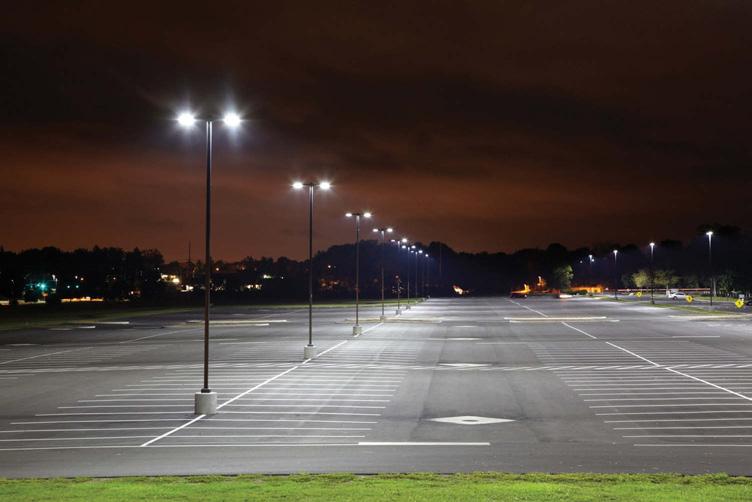

low, some colors in the light are either defi cient or too strong, so those colors will be perceived differently, regardless of CCT.
To get the light you want, fi rst determine whether you prefer a warm white or a cool white and select the desired CCT for your indoor or outdoor application. Then choose the highest available CRI so that colors will be rendered accurately. Energy-Star LED lamp products have a minimum CRI requirement similar to the color of fl uorescent and compact-fl uorescent lamps: at least 80 for CCT between 2,700 K and 4,000 K. However, some LED products now have CRIs of more than 90, which is considerably better than fl uorescent or CFL color quality and similar to incandescent or halogen color.
The same goes for light-beam uniformity. Because LEDs can use mirrors inside the fi xtures to precisely direct the light beams, they can provide better uniformity than high-pressure sodium, halogen, or incandescent lamps. LEDs also have more-defi ned cutoffs a and less glare and light pollution a than other technologies. t
6. 6 What does an L70 life
rating mean? Why does it r matter? m
A traditional incandescent lamp A will suddenly burn out. But an w LED will slowly lose brightness toward the end of its multi-year t life. The L70 rating is the amount of time it will take for the LED o to produce only 70% of its initial t lumen output. A long L70 life means the LED will stay bright longer. The L70 life is based on testing the LED product for 6,000 t hours, and then extending the h trend of the light output to the t 70% level.
7. What types of testing do
LEDs typically undergo? L
It depends on the manufacturer. All of GE’s products are thoroughA ly tested at in-house and independent labs, analyzing the bulbs’ d performance in various temperap ture and humidity environments. t For example, all new LED designs must undergo high-temperature testing at 140 F for at least 10% t of the bulb’s rated life to help o validate performance. That’s v 5,000 hours (or seven months) of 5 continuous testing under extreme c temperatures for a product with a rated life of 50,000 hours.
The company also tests the various subsystems. The electronics, LED components, and all critical materials that go into LED lights and systems are subjected to similar stressors. It’s all about fi nding the weakest links, identifying and stressing them to make sure the overall LED lights will perform reliably for years.
8. How effective is LED lighting at reducing
greenhouse gas emissions (GHG)?
Because of their high effi ciency, an investment in LED lighting is one of the most cost-effective
ways for businesses and commercial-building owners to curb GHG emissions and save money on energy. According to a 2011 McKinsey report, replacing ineffi cient lighting with LED lighting is “economically more attractive than any other means of CO 2 abatement.”
9. Is LED considered compliant
with restriction of hazardous substance (RoHS)?
Unlike technologies such as fl uorescent and metal halide, LEDs contain no mercury or other heavy metals. Therefore they are RoHScompliant.
10. Where can I install LEDs? Anywhere. Whether you’re looking for directional, decorative, or general lighting needs, there’s a place for LEDs. We see possibilities for LEDs in every lighting application. We now have LED lamps that fi t into almost all applications and use a standard Edison base. Many of today’s LEDs are dimmable.
One of the latest groundbreaking

A recessed ceiling fi xture with warm-edge LED technology provides many years of light with virtually no maintenance.


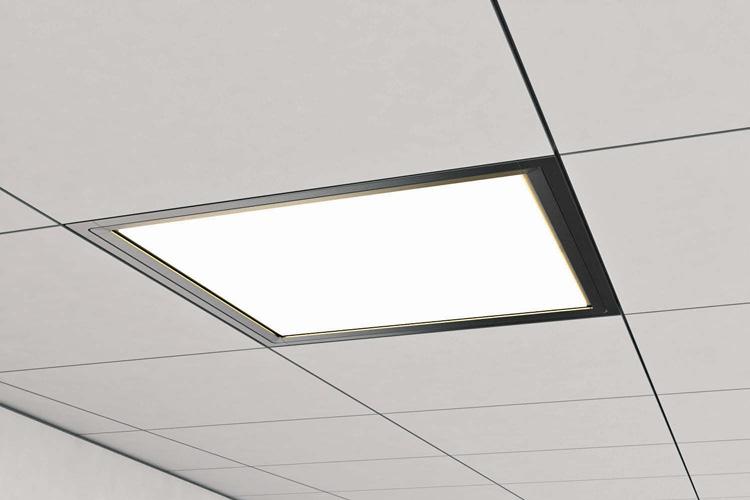
applications replaces traditional fl uorescent ceiling fi xtures with recessed LED troffers. These LED luminaires, which add sophisticated design elements to the once obtrusive fl uorescent tubes, emit a crisp, uniform light and reduce maintenance and energy expenses. The sleek

fl at-panel fi xtures recess into a ceiling and are easily installed c with existing electrical systems. w
In the foreseeable future, LEDs will be the most common form of lighting for nearly every kind of application. The e technology has come a long t way from the weak, blue light w typical of the earliest examples. t As it continues to improve, most A people will prefer LED light to p energy-hogging incandescents e and mercury-containing a fl uorescent lamps. Now that you know the ABCs of LEDs, you may k well be at the forefront of that w change.c

Linda Pastor is global product manager for LED replacement lamps at GE Lighting, Fairfi eld, CT, overseeing product evolutions of high-pressuresodium, incandescent, and LED lighting.
for free information, CIRCLE 3
and visit our digital magazine at www.cbpmagazine.com/digital/apr2012 and click on the icon.

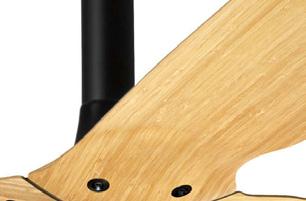
And now for something completely different…



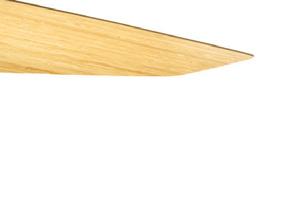
Haiku™ looks diff erent because it is diff erent. The sleek profile conceals Sensorless Drive Technology™ that delivers an 80% improvement in efficiency over conventional ceiling fan motors. In fact, Haiku exceeds ENERGY STAR® requirements by 400 to 750%. Made of Moso bamboo, a fast-renewing resource with the tensile strength of steel, Haiku Bamboo’s aerodynamic airfoils result in smooth, silent airfl ow at all speeds. Sophisticated control features include the exclusive Whoosh™ mode to simulate the variations of natural airfl ow, increasing perceived cooling by 40%. After a decade of engineering innovative air-movement solutions for large rooms, we heard your request: to make a small fan worthy of being called a Big Ass Fan. Here it is.



Bring big innovation to your project’s smaller spaces. (877) BIG-FANS | www.bigassfans.com/haiku
May be covered by one or more of the following U.S. Patents: 6,244,821; 6,589,016; 6,817,835; 6,939,108; 7,252,478; 7,284,960; D587,799; D607,988, D612,476; D614,757, and other patents pending. ©2012 Delta T Corporation dba the Big Ass Fan Company. All rights reserved. An ISO 9001:2008 certifi ed company




